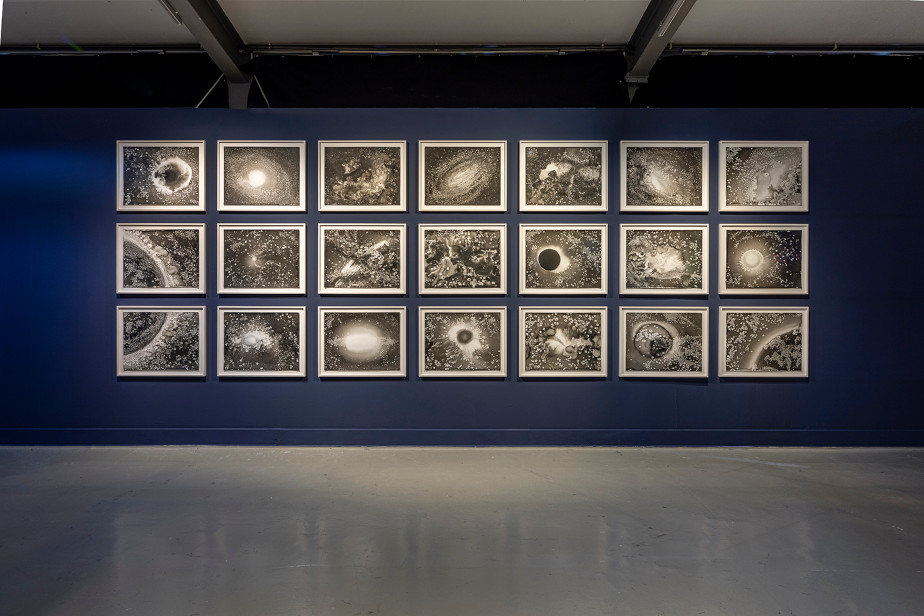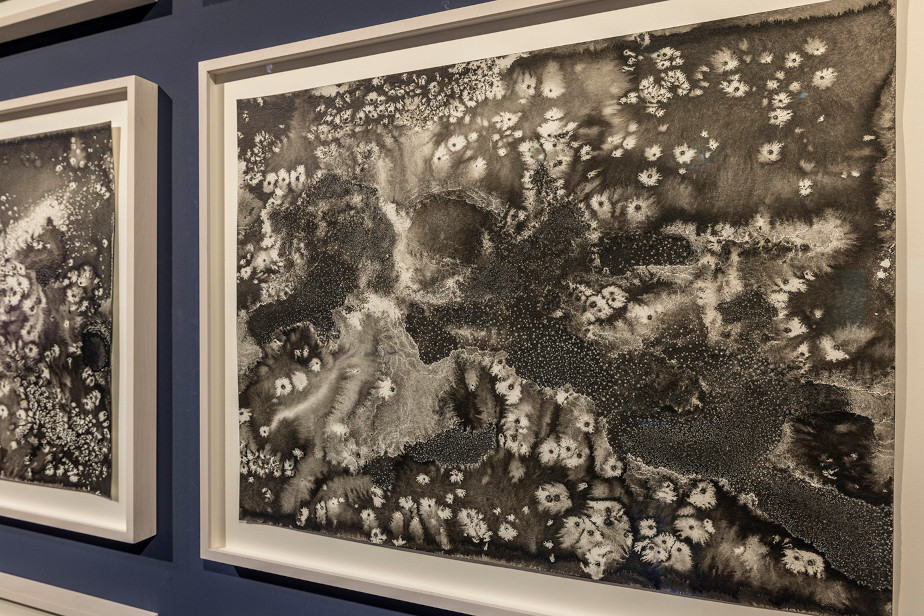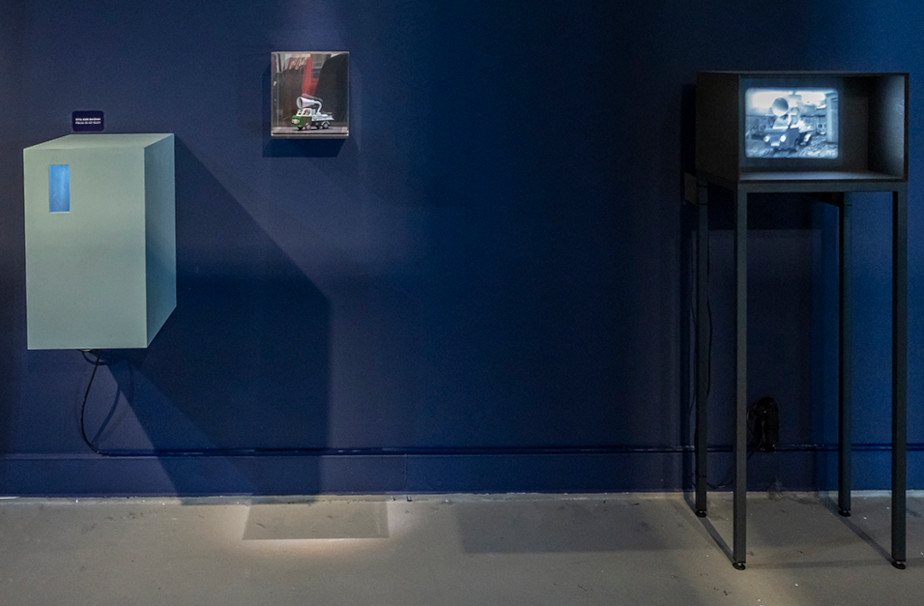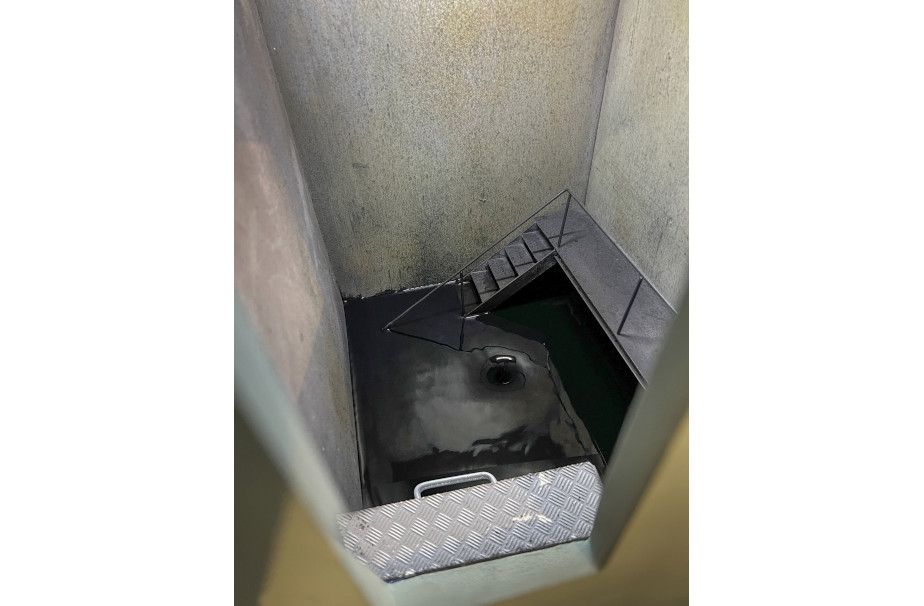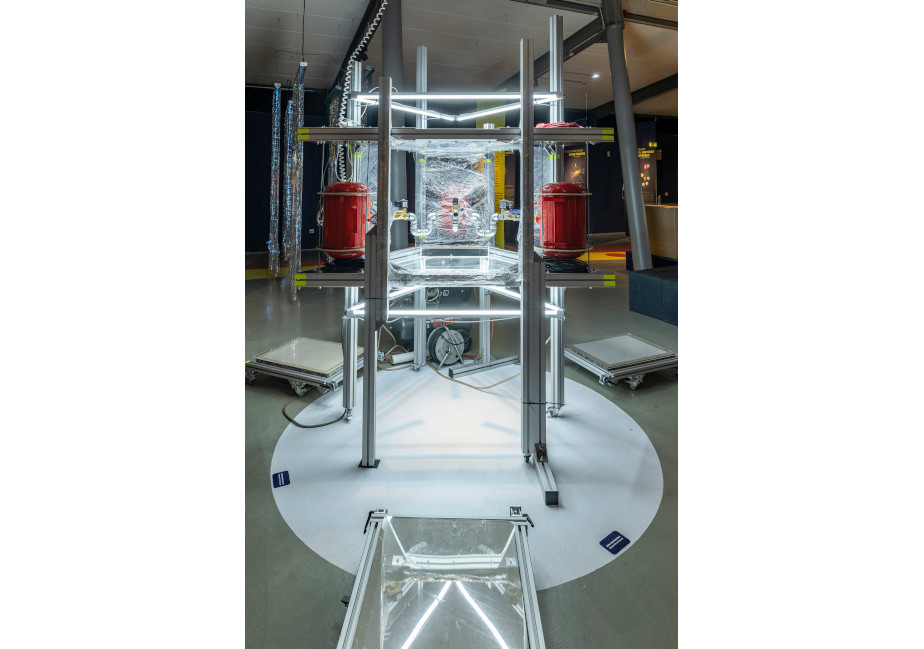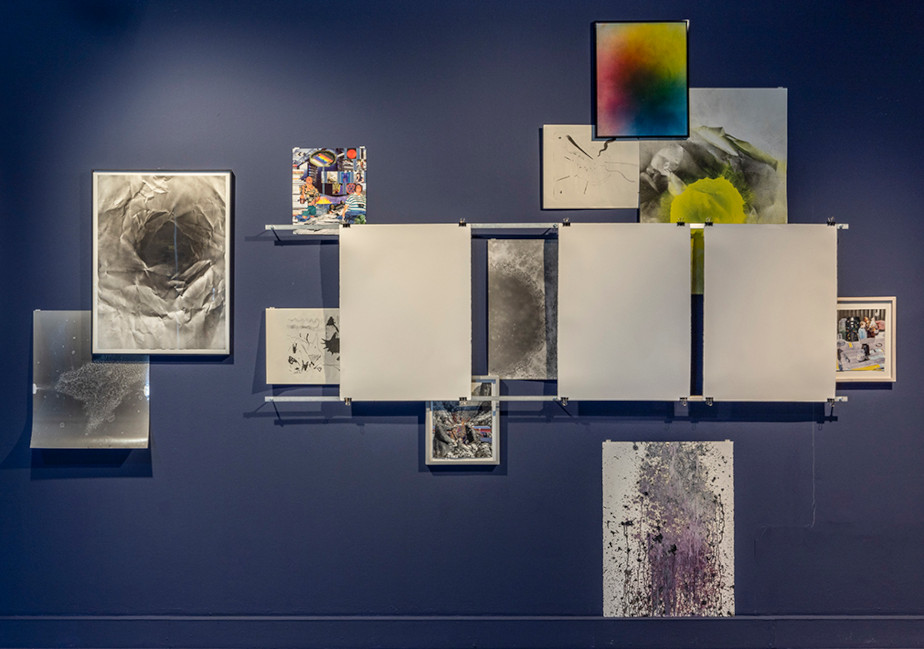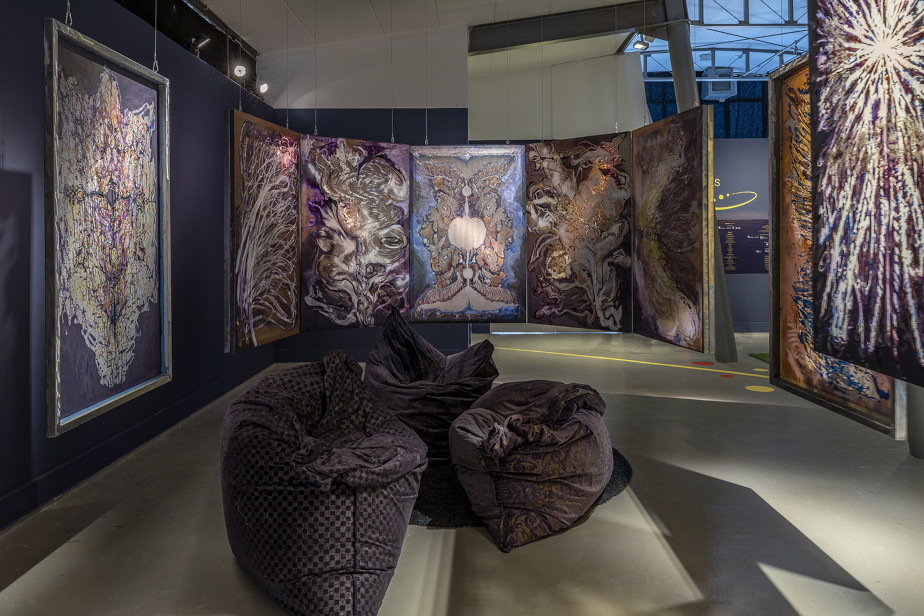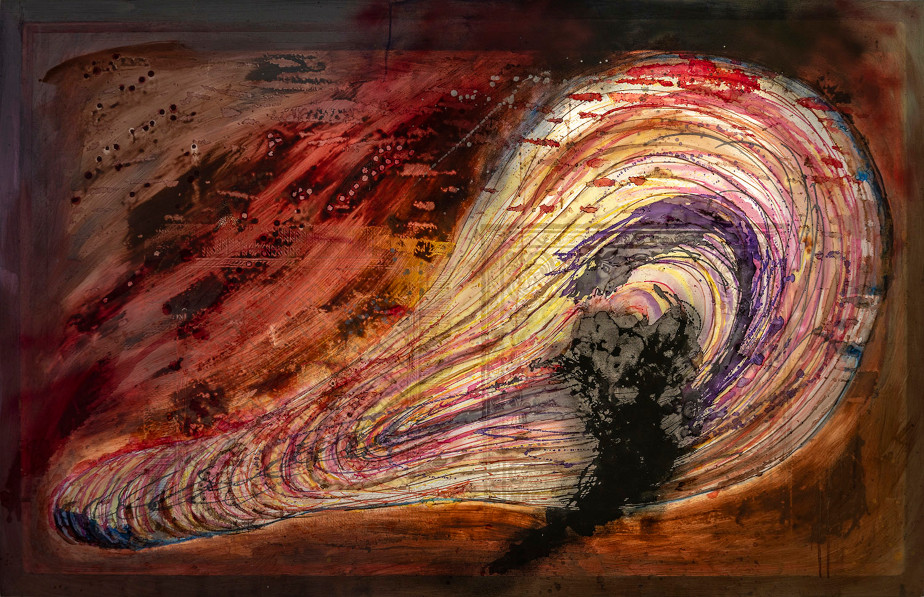art and science
Julia Münstermann
Entropy (2020–2022)
As a physical measure, entropy refers to the disorder that is progressively increasing in the universe. This is countered by the force of gravity, which brings forth entities such as galaxies, solar systems, and planets. In her series, Entropy, Julia Münstermann employs the opposing principles of order and disorder, structure and chaos to create pictorial compositions. Recalling black-and-white images captured by powerful space telescopes, this group of process-based ink works evokes interstellar nebulae, black holes, stellar clusters, and other cosmic phenomena: views into the depths of outer space, which appears in ever-changing configurations. The artist, who is active in the expansive field of painting and is concerned with scientific research and the visualization of the intangible, conflates intention and coincidence here in an aesthetic experiment. In her cosmic pictorial spaces, liquid ink collides with salt crystals, whose solvation energy generates unpredictable galactic structures. Thus, in the pictorial space, the emergence of formations in outer space is replayed, which spring forth from the confrontation between order and chaos.
Jan Köchermann
Frassek's Space Collector / film, 2018
Frassek's Cellar, 2018
Frassek's Space Collector / model, 2018
In the 1960s, the forgotten particle physicist Hubertus M. Frassek invented an automobile with a funnel-shaped collector as a measuring device to prove the existence of tiny black holes. Jan Köchermann let his reconstruction of Frassek's Space Collector first search for minute black holes on the DESY premises in Hamburg in 2017: the starting point of an artistic research project that has manifested itself in multiple forms. In blurred sepia tones, Köchermann's Super 8 film follows the eccentric scientist on his futuristic mission in the funnel vehicle. A peephole installation, in turn, provides a view of Frassek's Cellar, in the depths of which a dark vortex leads into nothingness like a black hole. As a miniature replica, the Space Collector makes reference to the imagination-driven vehicles of bold visions that provide the decisive impetus for scientific knowledge. Köchermann's spatial interventions and constructions are models of an expanded perception. They give shape to the inconceivable and make the invisible palpable—extending way beyond Frassek's Space Collector.
Jana Schumacher
Jigsaw (2022)
In Jana Schumacher's drawings and installations, abstract structures are condensed into ornaments of existence. The artist spans an arc from the microcosm to the macrocosm, which leads into the depths of outer space. Her spatial ensemble, Jigsaw, symbolizes the quest of science, which also applies to art and humanity in general, to solve the great riddles of the universe: mysteries that particle physics is seeking to unravel through the exploration of dark matter. Countless black puzzle pieces are piled up into a mound on a surreal-looking conference table, which is modeled after Stanley Kubrick's satirical sci-fi classic, Dr. Strangelove (1964). Assembling the puzzle poses a near unsurmountable challenge that can only be mastered collectively, as the round table suggests. The potential overall picture that could emerge from the individual pieces of the game is just as elusive as dark matter itself: an enigmatic substance, which still continues to retain secrets. As in other works as well, Schumacher here addresses the confrontation with the unknown, which propels artists and scientists alike.
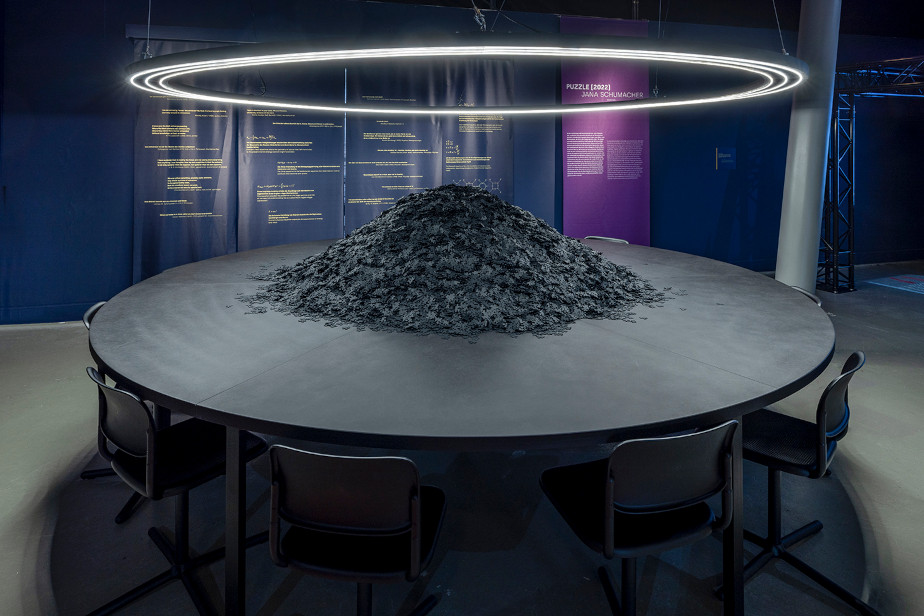
Marcel Grosse
Accelerator3 (2022)
Scientific procedures form the basis of Marcel Große's open-ended artistic experiments. In his experimental set-ups, he employs a wide range of materials: from devices derived from laboratory contexts, to plumbing supplies, to compressed air tanks used in vehicle production. The latter are also components of his latest construction, Accelerator3, which is inspired by the apparatus used in particle physics to simulate the cosmic Big Bang and to measure dark matter. In Große's work, however, the associated particle collision at top speed follows its own unpredictable system: three compressed air tanks facing each other are simultaneously discharged in a closed compartment. The resulting pressure wave disperses ink particles, which collide here with lithographic stones. Analogue prints replace digital recording methods: a cooperation with the museum's lithography workshop. In his sculptures and spatial installations, Große seeks to make processes visible. Invariably, he thus incorporates the element of surprise in his works, embracing possible failure. Analogous to methods of research, the artist's guiding principle lies in productive deviation: in the exception that creates new rules.
Tanja Hehmann
Endingsbeginnings (2022)
In her installation, Endingsbeginnings, Tanja Hehmann addresses the question of the end of the universe posed at the conclusion of the exhibition with a multi-perspective approach to the eternal cycles that unfold between becoming and passing, birth and death. Scenarios of cosmic demise inspire the artist to ponder the primordial foundations of life, our own mortality, and our incorporation as human beings into the overall scheme of the world and the universe. Consisting of fabric-covered aluminum frames derived from silkscreen printing, the environment she has constructed is modeled on the nave chapel of a church. Conceived as a meditative space of retreat, it counters the high-tech methods of scientific research with sensual organic forms: a poetic visual landscape consisting of both semi-transparent and opaque, tranquil and expressive images, which combine figurative and abstract geometric motifs, prefabricated patterns, drawing, and gestural painting. In the interplay of the various elements, the artist opens up an associative sphere that evokes reflection of the intangible though immersion in the here and now.
